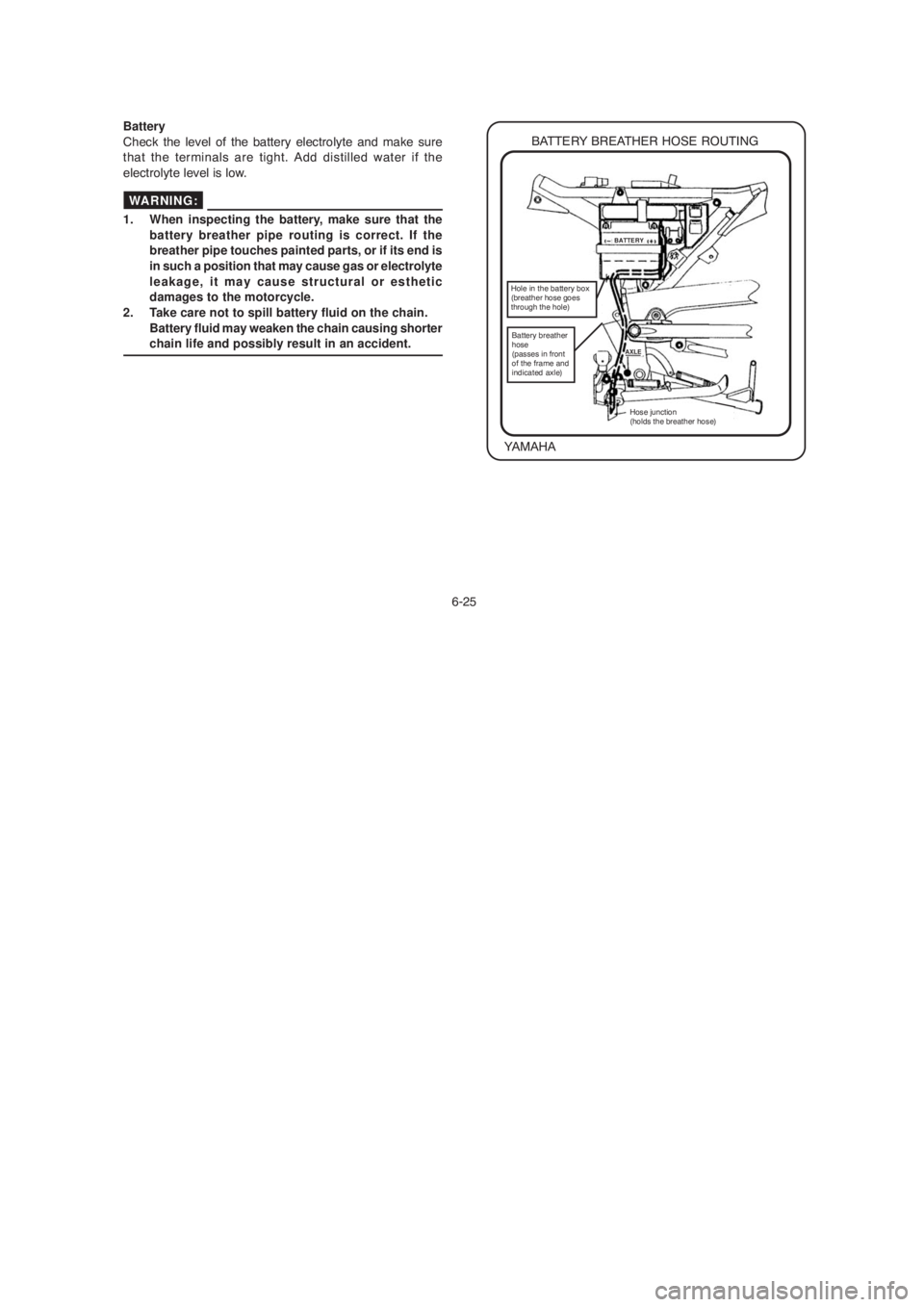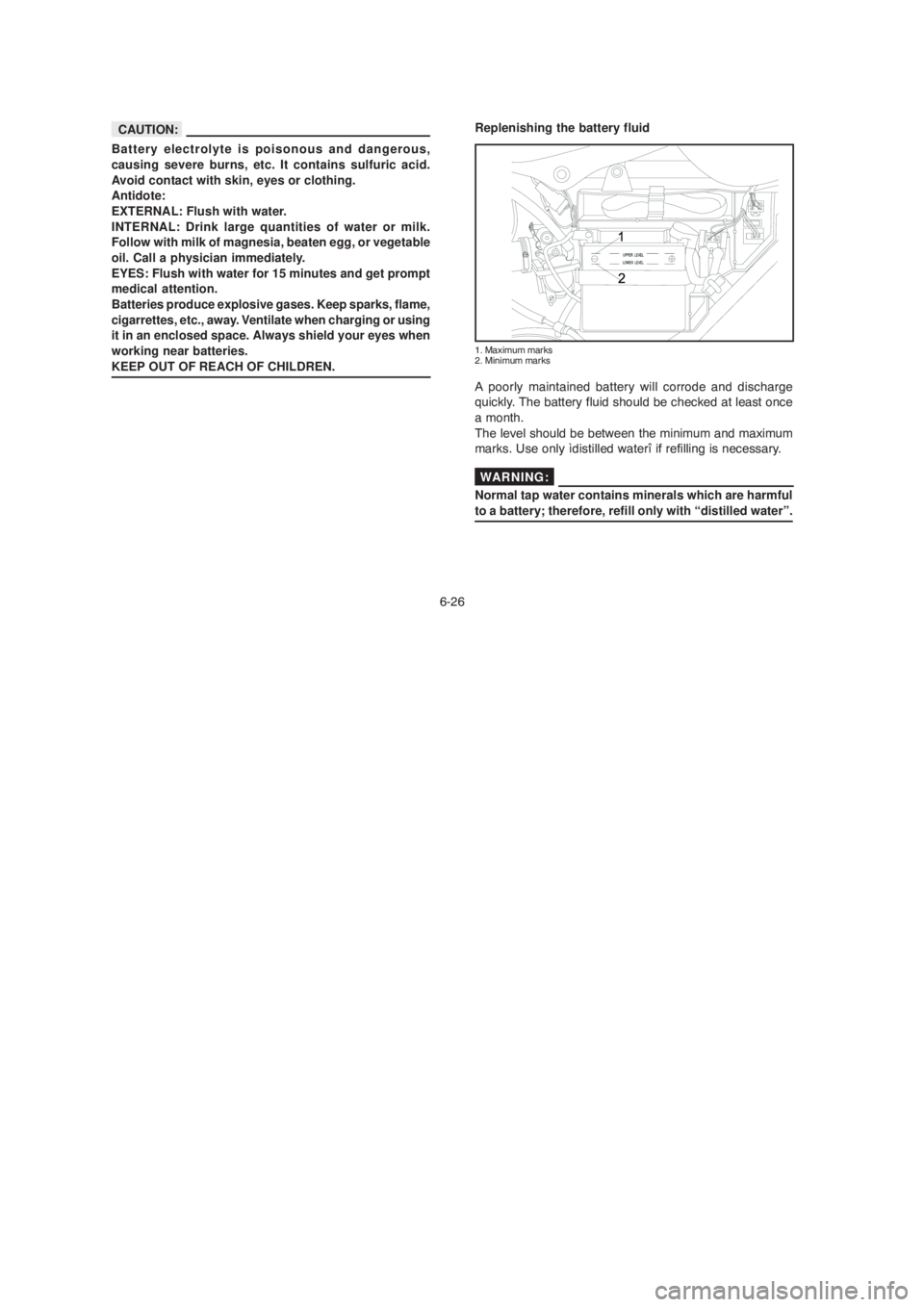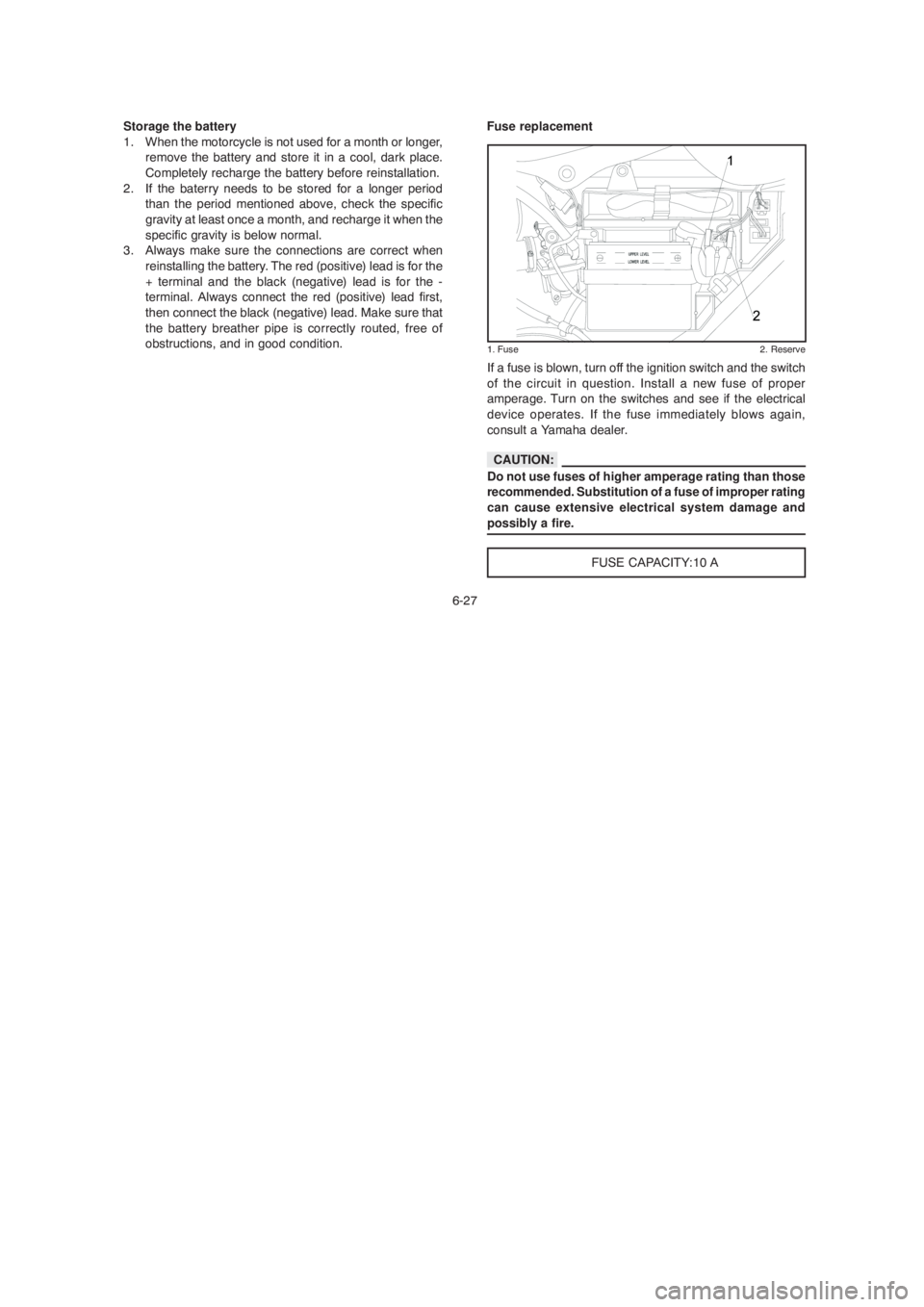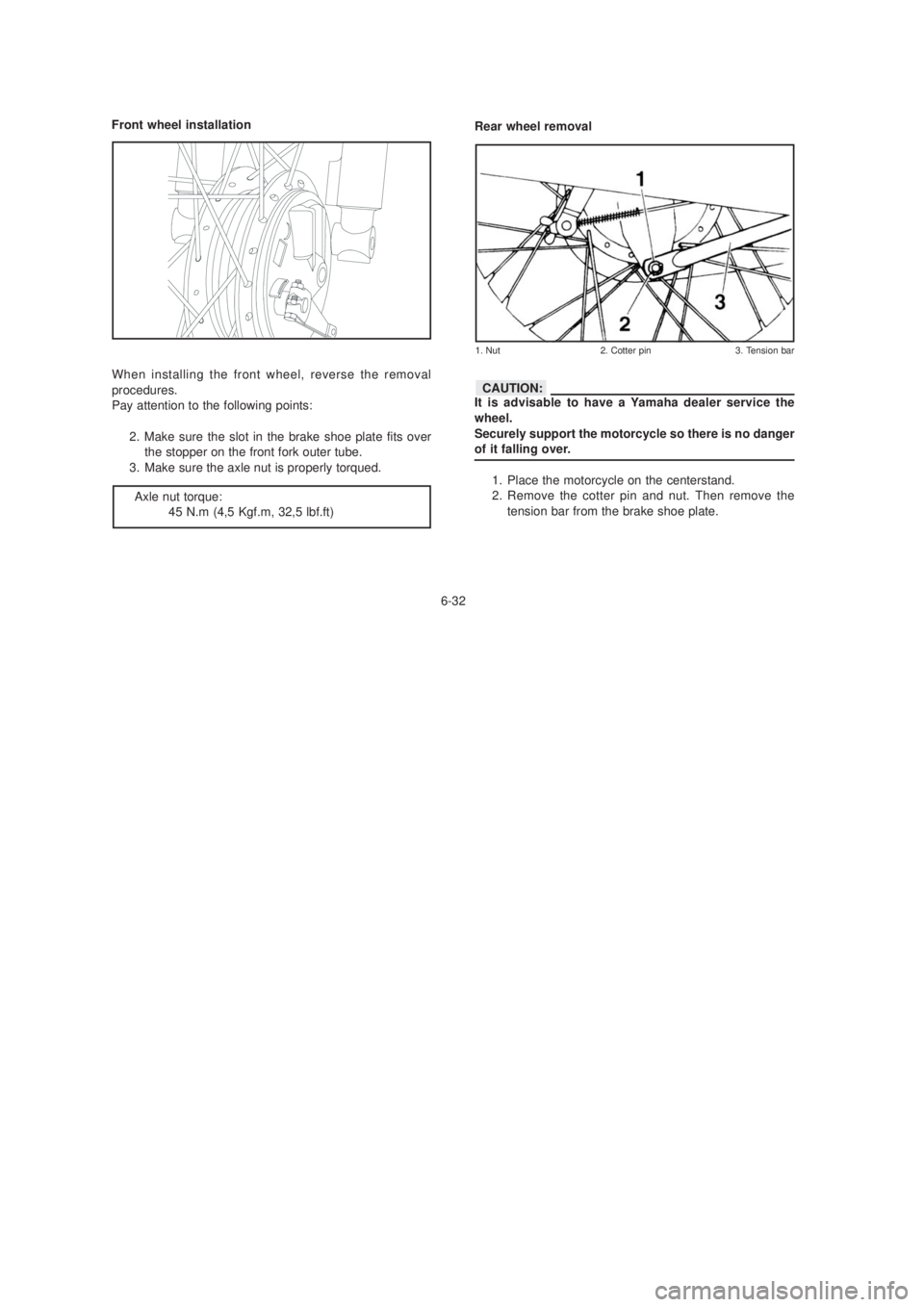Page 65 of 83

6-25
BATTERY BREATHER HOSE ROUTING
YAMAHA Battery
Check the level of the battery electrolyte and make sure
that the terminals are tight. Add distilled water if the
electrolyte level is low.
1. When inspecting the battery, make sure that the
battery breather pipe routing is correct. If the
breather pipe touches painted parts, or if its end is
in such a position that may cause gas or electrolyte
leakage, it may cause structural or esthetic
damages to the motorcycle.
2. Take care not to spill battery fluid on the chain.
Battery fluid may weaken the chain causing shorter
chain life and possibly result in an accident.
WARNING:
BATTERY
AXLE
Hole in the battery box
(breather hose goes
through the hole)
Battery breather
hose
(passes in front
of the frame and
indicated axle)
Hose junction
(holds the breather hose)
6-25
BATTERY BREATHER HOSE ROUTING
YAMAHA Battery
Check the level of the battery electrolyte and make sure
that the terminals are tight. Add distilled water if the
electrolyte level is low.
1. When inspecting the battery, make sure that the
battery breather pipe routing is correct. If the
breather pipe touches painted parts, or if its end is
in such a position that may cause gas or electrolyte
leakage, it may cause structural or esthetic
damages to the motorcycle.
2. Take care not to spill battery fluid on the chain.
Battery fluid may weaken the chain causing shorter
chain life and possibly result in an accident.
WARNING:
BATTERY
AXLE
Hole in the battery box
(breather hose goes
through the hole)
Battery breather
hose
(passes in front
of the frame and
indicated axle)
Hose junction
(holds the breather hose)
Page 66 of 83

6-26
Battery electrolyte is poisonous and dangerous,
causing severe burns, etc. It contains sulfuric acid.
Avoid contact with skin, eyes or clothing.
Antidote:
EXTERNAL: Flush with water.
INTERNAL: Drink large quantities of water or milk.
Follow with milk of magnesia, beaten egg, or vegetable
oil. Call a physician immediately.
EYES: Flush with water for 15 minutes and get prompt
medical attention.
Batteries produce explosive gases. Keep sparks, flame,
cigarrettes, etc., away. Ventilate when charging or using
it in an enclosed space. Always shield your eyes when
working near batteries.
KEEP OUT OF REACH OF CHILDREN.
A poorly maintained battery will corrode and discharge
quickly. The battery fluid should be checked at least once
a month.
The level should be between the minimum and maximum
marks. Use only ìdistilled waterî if refilling is necessary.
Normal tap water contains minerals which are harmful
to a battery; therefore, refill only with “distilled water”. Replenishing the battery fluid
1. Maximum marks
2. Minimum marks
CAUTION:
WARNING:
6-26
Battery electrolyte is poisonous and dangerous,
causing severe burns, etc. It contains sulfuric acid.
Avoid contact with skin, eyes or clothing.
Antidote:
EXTERNAL: Flush with water.
INTERNAL: Drink large quantities of water or milk.
Follow with milk of magnesia, beaten egg, or vegetable
oil. Call a physician immediately.
EYES: Flush with water for 15 minutes and get prompt
medical attention.
Batteries produce explosive gases. Keep sparks, flame,
cigarrettes, etc., away. Ventilate when charging or using
it in an enclosed space. Always shield your eyes when
working near batteries.
KEEP OUT OF REACH OF CHILDREN.
A poorly maintained battery will corrode and discharge
quickly. The battery fluid should be checked at least once
a month.
The level should be between the minimum and maximum
marks. Use only ìdistilled waterî if refilling is necessary.
Normal tap water contains minerals which are harmful
to a battery; therefore, refill only with “distilled water”. Replenishing the battery fluid
1. Maximum marks
2. Minimum marks
CAUTION:
WARNING:
Page 67 of 83

Storage the battery
1. When the motorcycle is not used for a month or longer,
remove the battery and store it in a cool, dark place.
Completely recharge the battery before reinstallation.
2. If the baterry needs to be stored for a longer period
than the period mentioned above, check the specific
gravity at least once a month, and recharge it when the
specific gravity is below normal.
3. Always make sure the connections are correct when
reinstalling the battery. The red (positive) lead is for the
+ terminal and the black (negative) lead is for the -
terminal. Always connect the red (positive) lead first,
then connect the black (negative) lead. Make sure that
the battery breather pipe is correctly routed, free of
obstructions, and in good condition.
6-27
If a fuse is blown, turn off the ignition switch and the switch
of the circuit in question. Install a new fuse of proper
amperage. Turn on the switches and see if the electrical
device operates. If the fuse immediately blows again,
consult a Yamaha dealer.
WARNING:
Do not use fuses of higher amperage rating than those
recommended. Substitution of a fuse of improper rating
can cause extensive electrical system damage and
possibly a fire.
FUSE CAPACITY:10 A Fuse replacement
1. Fuse 2. Reserve
CAUTION:
Storage the battery
1. When the motorcycle is not used for a month or longer,
remove the battery and store it in a cool, dark place.
Completely recharge the battery before reinstallation.
2. If the baterry needs to be stored for a longer period
than the period mentioned above, check the specific
gravity at least once a month, and recharge it when the
specific gravity is below normal.
3. Always make sure the connections are correct when
reinstalling the battery. The red (positive) lead is for the
+ terminal and the black (negative) lead is for the -
terminal. Always connect the red (positive) lead first,
then connect the black (negative) lead. Make sure that
the battery breather pipe is correctly routed, free of
obstructions, and in good condition.
6-27
If a fuse is blown, turn off the ignition switch and the switch
of the circuit in question. Install a new fuse of proper
amperage. Turn on the switches and see if the electrical
device operates. If the fuse immediately blows again,
consult a Yamaha dealer.
WARNING:
Do not use fuses of higher amperage rating than those
recommended. Substitution of a fuse of improper rating
can cause extensive electrical system damage and
possibly a fire.
FUSE CAPACITY:10 A Fuse replacement
1. Fuse 2. Reserve
CAUTION:
Page 68 of 83
6-28
1. Screw
Headlight bulb replacement
If the headlight bulb burns out, replace the bulb as follows:
1. Remove the screws.2. Loosen the bulb connectors and remove the rubber cover.
3. Turn the bulb socket counterclockwise and remove the
bulb.
Keep flammable products and your hands away from the
bulb while it is on, as it is hot. Do not touch the bulb until it
cools down
1. Rubber cover
CAUTION:
6-28
1. Screw
Headlight bulb replacement
If the headlight bulb burns out, replace the bulb as follows:
1. Remove the screws.2. Loosen the bulb connectors and remove the rubber cover.
3. Turn the bulb socket counterclockwise and remove the
bulb.
Keep flammable products and your hands away from the
bulb while it is on, as it is hot. Do not touch the bulb until it
cools down
1. Rubber cover
CAUTION:
Page 69 of 83

6-29
1. Bulb
4. Put a new bulb, install the socket and the bulb rubber
cover.
5. Reconnect the connectors.
6. Reinstall the headlight assy. If it is necessary to adjust
the headlight beam, please consult a Yamaha dealer.
Avoid touching the glass part of the headlight bulb to
keep it free from oil, otherwise the transparency of
the glass, the life of the bulb and the luminous flux
will be adversely affected. If the headlight bulb gets
soiled, thoroughly clean it with a cloth moistened with
alcohol or lacquer thinner.
WARNING:
6-29
1. Bulb
4. Put a new bulb, install the socket and the bulb rubber
cover.
5. Reconnect the connectors.
6. Reinstall the headlight assy. If it is necessary to adjust
the headlight beam, please consult a Yamaha dealer.
Avoid touching the glass part of the headlight bulb to
keep it free from oil, otherwise the transparency of
the glass, the life of the bulb and the luminous flux
will be adversely affected. If the headlight bulb gets
soiled, thoroughly clean it with a cloth moistened with
alcohol or lacquer thinner.
WARNING:
Page 70 of 83
6-30 Turn signal bulb replacement
1. Remove the screws and the lens.
2. Push the bulb inward and turn it counterclockwise.
3. Place a new bulb in the socket.
4. Install the lens and the screws.
Do not over-tighten the screws as the lens may break.Taillight bulb replacement
1. Remove the lens.
2. Push the bulb inward and turn it counterclockwise.
3. Place a new bulb in the socket.
4. Install the lens.
CAUTION:
6-30 Turn signal bulb replacement
1. Remove the screws and the lens.
2. Push the bulb inward and turn it counterclockwise.
3. Place a new bulb in the socket.
4. Install the lens and the screws.
Do not over-tighten the screws as the lens may break.Taillight bulb replacement
1. Remove the lens.
2. Push the bulb inward and turn it counterclockwise.
3. Place a new bulb in the socket.
4. Install the lens.
CAUTION:
Page 71 of 83
6-31
It is advisable to have a Yamaha dealer service the
wheel.
Securely support the motorcycle so there is no danger
of it falling over. Front wheel removal
1. Place the motorcycle on the centerstand.
2. Loosen the front brake cable by loosening the adjusting
bolt.
3. Remove the speedometer cable by loosening the cable
clip.
4. With the help of ar appropriete tool completely loose
the axle nut and remove it.
1. Lock nut 2. Clip 3. Axle nut
CAUTION:
6-31
It is advisable to have a Yamaha dealer service the
wheel.
Securely support the motorcycle so there is no danger
of it falling over. Front wheel removal
1. Place the motorcycle on the centerstand.
2. Loosen the front brake cable by loosening the adjusting
bolt.
3. Remove the speedometer cable by loosening the cable
clip.
4. With the help of ar appropriete tool completely loose
the axle nut and remove it.
1. Lock nut 2. Clip 3. Axle nut
CAUTION:
Page 72 of 83

6-32
Front wheel installation
When installing the front wheel, reverse the removal
procedures.
Pay attention to the following points: 2. Make sure the slot in the brake shoe plate fits overthe stopper on the front fork outer tube.
3. Make sure the axle nut is properly torqued.
Axle nut torque: 45 N.m (4,5 Kgf.m, 32,5 lbf.ft)
Rear wheel removal
It is advisable to have a Yamaha dealer service the
wheel.
Securely support the motorcycle so there is no danger
of it falling over. 1. Place the motorcycle on the centerstand.
2. Remove the cotter pin and nut. Then remove thetension bar from the brake shoe plate.
1. Nut 2. Cotter pin 3. Tension bar
CAUTION:
6-32
Front wheel installation
When installing the front wheel, reverse the removal
procedures.
Pay attention to the following points: 2. Make sure the slot in the brake shoe plate fits overthe stopper on the front fork outer tube.
3. Make sure the axle nut is properly torqued.
Axle nut torque: 45 N.m (4,5 Kgf.m, 32,5 lbf.ft)
Rear wheel removal
It is advisable to have a Yamaha dealer service the
wheel.
Securely support the motorcycle so there is no danger
of it falling over. 1. Place the motorcycle on the centerstand.
2. Remove the cotter pin and nut. Then remove thetension bar from the brake shoe plate.
1. Nut 2. Cotter pin 3. Tension bar
CAUTION: